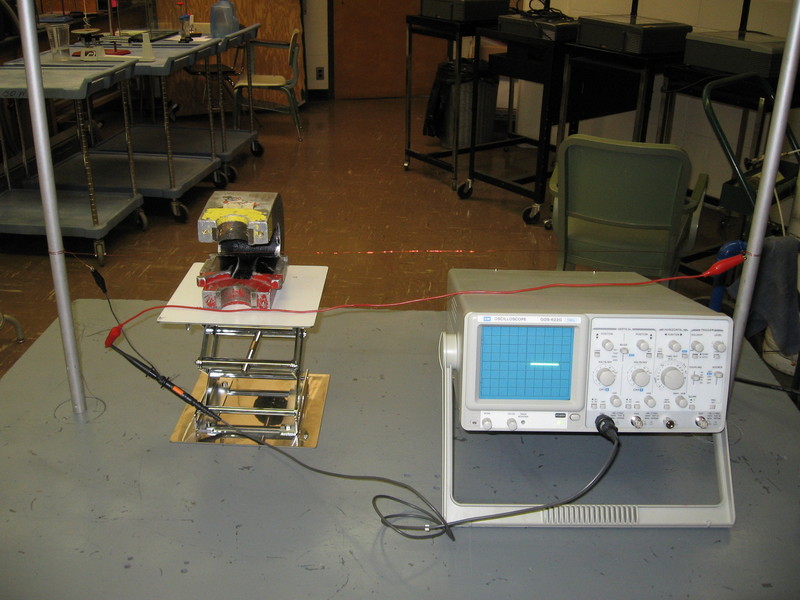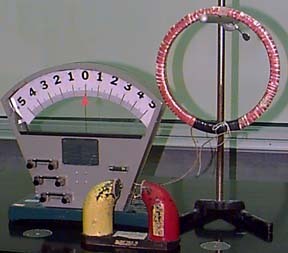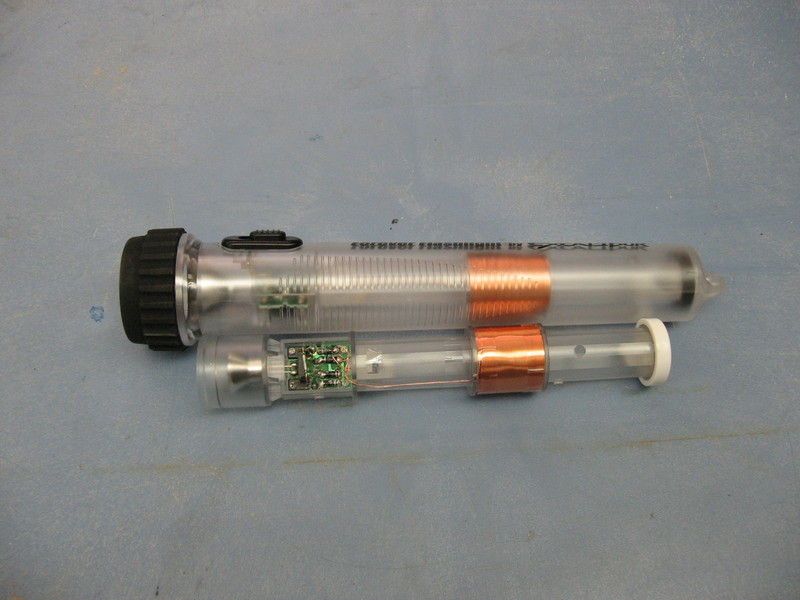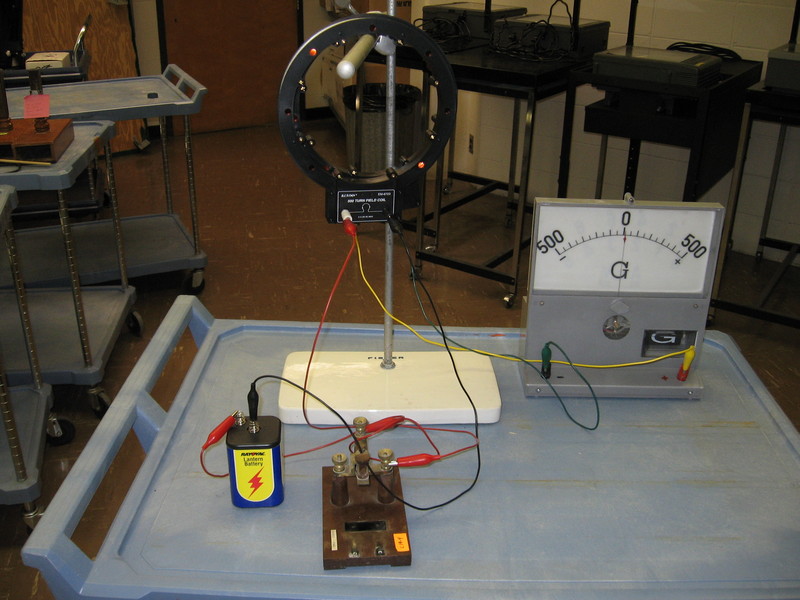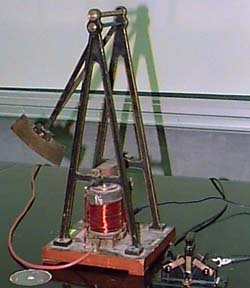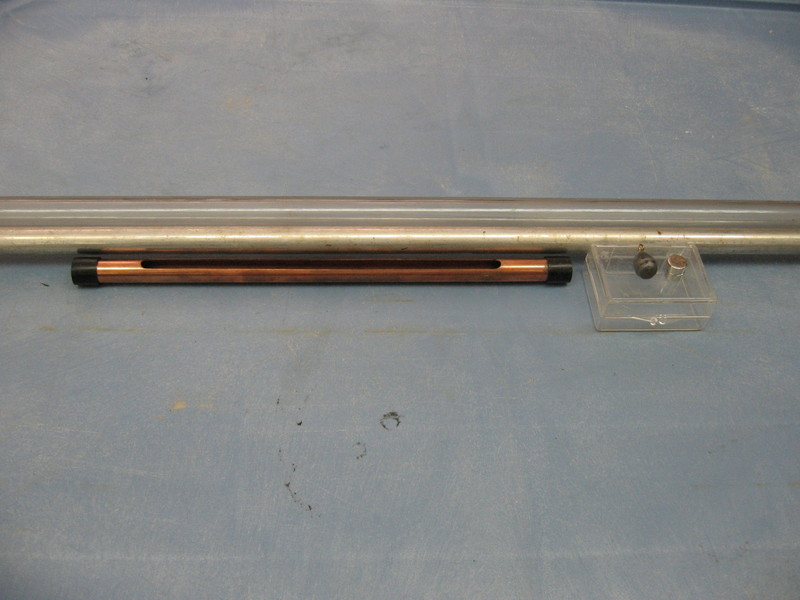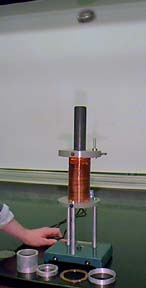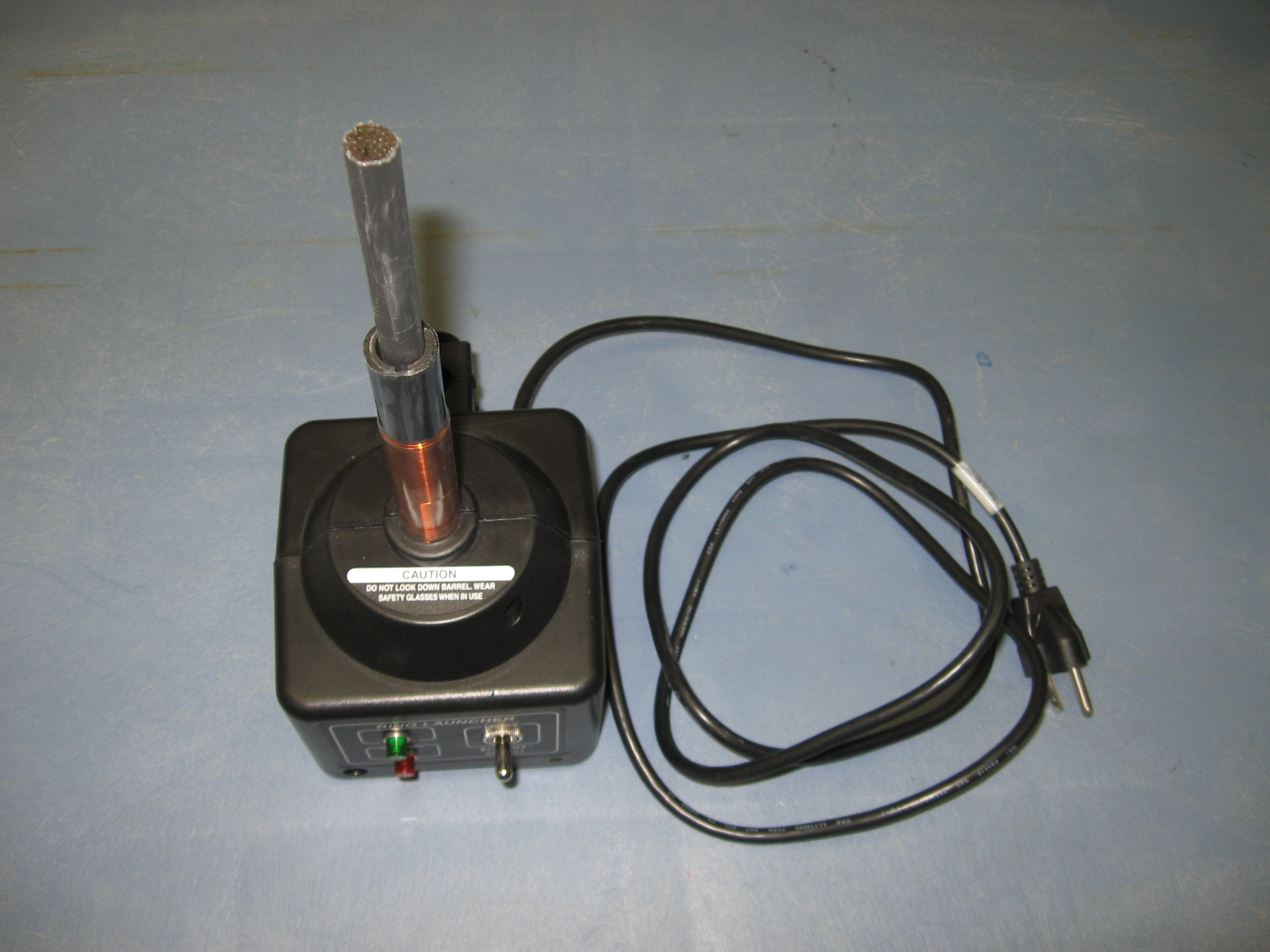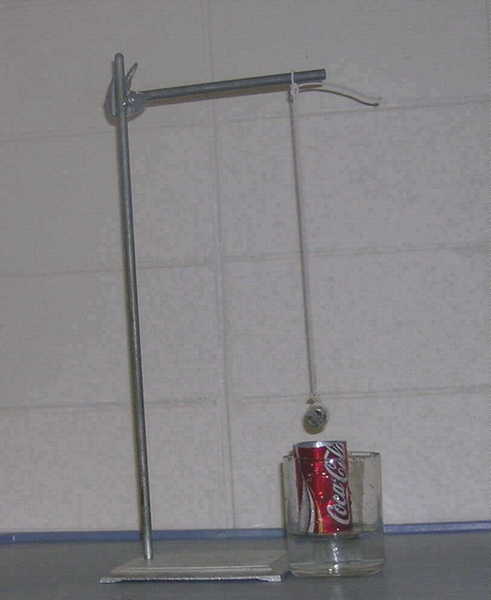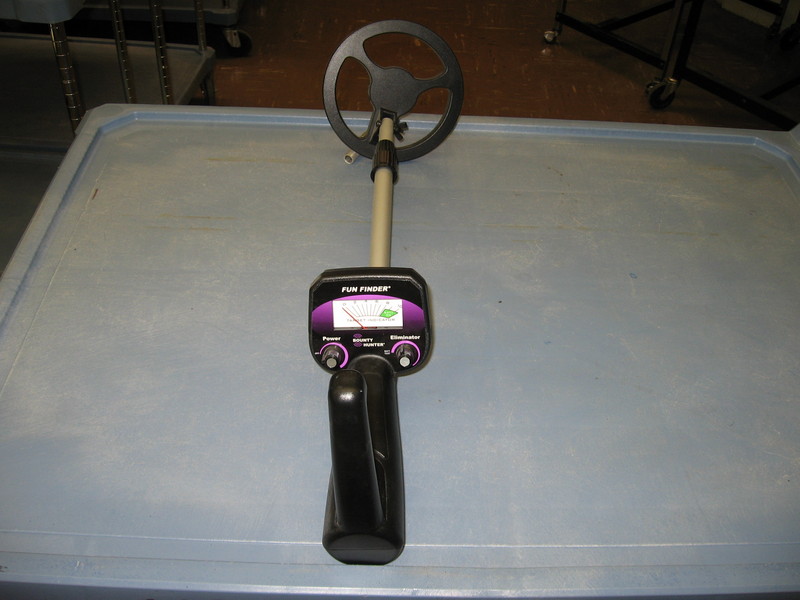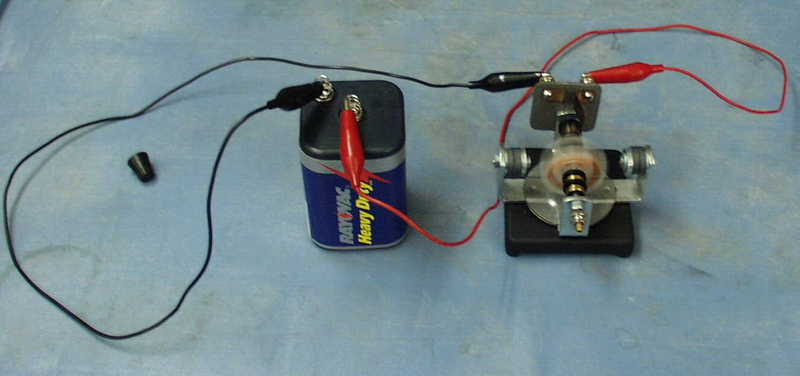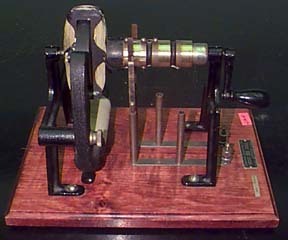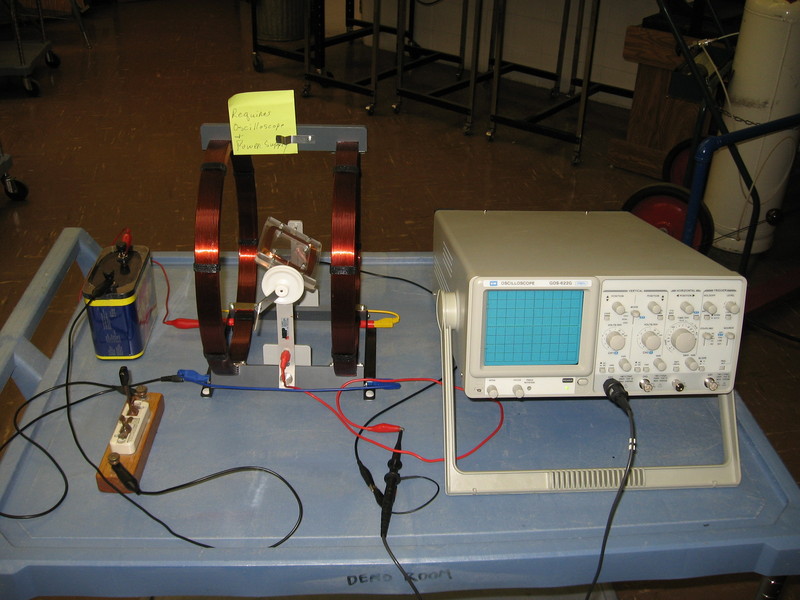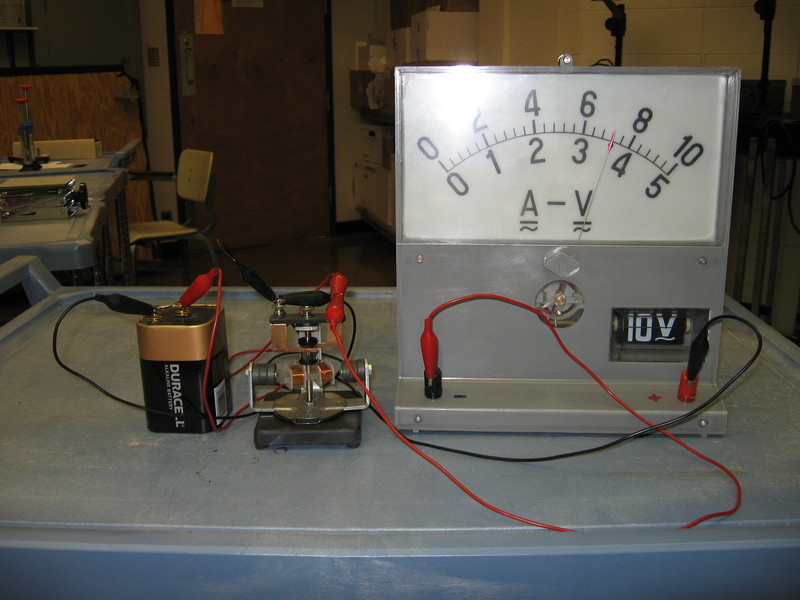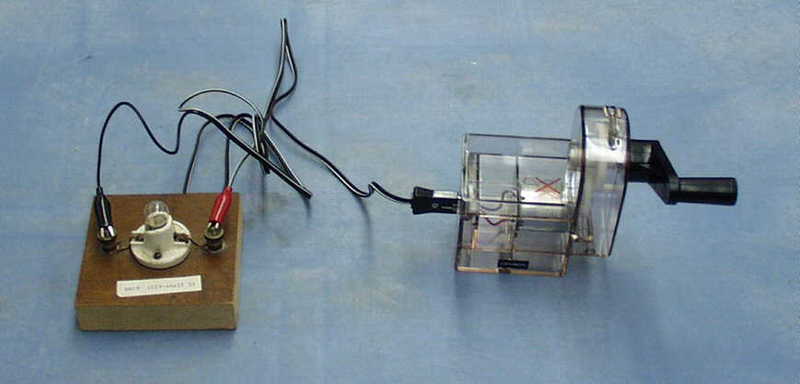ELECTROMAGNETIC INDUCTION
5K10.15 INDUCED EMF IN WIRE5K10.20 INDUCTION COIL AND MAGNET
5K10.25 FLASHLIGHT CHARGED BY INDUCTION
5K10.30 INDUCTION WITH COILS AND BATTERY
5K20.10 EDDY CURRENTS IN PENDULUM
5K20.25 MAGNETS IN EDDY TUBE
5K20.30 JUMPING RING
5K20.50 SPINNING COKE CAN
5K20.70 METAL DETECTOR
5K40.10 DC MOTOR
5K40.40 MOTOR/GENERATOR #1
5K40.41 GENERATOR #2 (noise pickup problem))
5K40.71 MOTOR ACTS AS GENERATOR (replaced by a different version)
5K40.80 HAND CRANKED GENERATOR
|
5K10.15 Induced EMF in Wire Attach wire to rods. Place large magnet so wire is between poles. Attach cable to each end of wire and connect to oscilloscope. Pull on wire and let go. A distorted and damped sine wave will appear on the oscilloscope. Some trial and error need to adjust volt/div and time/div controls. Setup Requirements:Advance notice needed to assemble and test. Equations: EMF = BLV Safety Issues: Heavy and strong magnet |
|
5K10.20 Induction coil and Magnet A) A coil attached to meter is moved toward or away from a magnet. B) A magnet is moved in and out of a coil of wire attached to a galvanometer. Either way you get a deflection of the meter.
Picture: Need New Picture. Coil and magnet have been replaced.
Setup Requirements: Assembled as needed. Coil and magnet may differ from that shown in photo. Equations: A) Uses Lorentz equation F = qvxB. B) Classical explanation uses Faraday's Law and Lenz's Law. An EMF is induced that is proportional to time rate of change of magnetic flux. Safety Issues: Heavy and strong magnet
Added Info: In v x B, the v is the speed in lab frame not relative to magnet. According to special relativity, in case B an electric field is produced in the coil proportional to u x B where u is speed of magnet in lab frame. |
|
5K10.25 Flashlight Charged by Induction coil A flashlight is available that uses a capacitor charged up by moving a magnet back and forth through a coil instead of batteries. Output of coil is fed to capacitor through a full wave rectifier so it charges up with magnet going right to left and vice versa. Setup Requirements: Off the shelf. You will have to move the magnet back and forth a number of times to get the LEDS to light up.
Equations: Faraday's Law: An EMF is induced that is proportional to time rate of change of magnetic flux. Safety Issues: Strong magnet. |
|
5K10.30 Induction with Coils and Battery Changing current in one coil induces EMF in other coil. Tap switch and observe meter deflection. Transformer for Crookes tube uses changing DC to produce high voltage.
Setup Requirements: Assembled as needed. Attach one coil to a galvanometer, another to a battery and switch. Equations: Emf = - N df /dt. f = B.A . Safety Issues: None |
|
5K20.10 Eddy Currents in Pendulum A copper sheet is swung through a large electromagnet. Eddy currents will cause device to stop swinging.
Setup Requirements: Use one or two 6v batteries depending on how fast you want it to stop. Equations: None Safety Issues: None |
|
5K20.25 Magnets in Eddy Tubes Drop a magnet in clear tube. Then switch to aluminum tube. The magnet in metal tube falls slowly. Drop a lead weight down tube to show it is not just the tight fit. Setup Requirements: Minimal. Use two small disk magnets. A short copper tube version with opening along side is available. Equations: Eddy currents produced in tube produce magnetic field that opposes field of falling magnet. Safety Issues: Small magnets are brittle. |
|
5K20.30 Jumping Ring A solid aluminum ring on the vertical transformer core jumps while a split ring does not. New version includes coil connected to bulb which will glow when ring placed around core. Setup Requirements: Minimal. If you do not specify which one, you will get the older one. Equations: Current induced in ring by changing flux leads to force on ring. Force alternates between attraction and repulsion as AC current goes through cycle. Net repulsion due to ring acting as resistor and inductor. Safety Issues: AC voltage at terminals of version in left picture.
Added Info: The equation for this device is in Solutions Manual for Corson & Lorraine Electromagnetic Fields and Waves textbook. Article available explaining operation. |
|
5K20.50 Spinning Coke Can Demonstration of an effect of a varying magnetic field. Float an empty aluminum soft drink can with top removed in water. First show that a magnet will not noticeably attract can. Suspend horizontally a small but strong cylindrical magnet so it is inside but not touching can. Twist the string so the magnet spins. The can will start spinning also.
Setup Requirements: Assembled as needed Equations: None Safety Issues: Strong brittle magnet |
|
5K20.70 Metal Detector Metal detectors use induction to detect metals. Use as an example of practical uses of eddy currents. A brief explanation of how a metal detector works can be found at http://micro.magnet.fsu.edu/electromag/java/detector/index.htm Setup Requirements: Minimal. Batteries may need replacing. Practice using in stock room before using in class. Equations: None Safety Issues: None |
|
5K40.10 DC Motor DC motor demonstration. Larger models also available. Setup Requirements: Use 6v battery. If it does not spin, start spinning by hand.
Equations: dF = I dl X B
Safety Issues: None for small one. |
|
A large AC/DC motor/generator has both slip and split rings. Generator output weak. Works well as motor.
Setup Requirements: Assembled as needed. Needs 12v and 6v batteries. Do not complete circuit until ready to use to avoid draining batteries. Disconnect batteries when finished. Equations: Motor: dF = I dl x B Generator: F = qvXB, F = qE, Emf = Integral of v X B .dl.
Safety Issues:Keep clear of handle when using as motor. Disconnect batteries when finished. |
|
5K40.41 Generator #2 Simple generator. Noise pickup problem. Magnetic field is provided by large coils. Requires oscilloscope to view output. Battery and switch in photograph have been replaced by a power supply. Setup Requirements: Assembled as needed. Use Tektronix power supply for coils. Adjust power supply for 2.3v with nothing connected. Connect circuit and turn on. If red light (C.C.) comes on check current. Use between 2.9 & 3A. Reduce voltage if current too high. Adjust current knob if red light comes on too soon. Set current knob so light comes on slightly above 3A. If the coils are too close to the scope the trace may be tilted. If you are turning the small coil by hand the scope sec/div control needs to be on tenths of second scales. Adjust volt/div until spot clearly moves up and down as it moves across the screen. Crank handle needs to be insulated or wear gloves to avoid picking up high frequency noise. Prior practice recommended.
Equations: F=qvXB, Emf = Integral of v x B .dl
Safety Issues: Limit power supply to 3A.
|
|
5K40.80 Hand Cranked Generator Hand cranked generator will light up flashlight bulb. A Genecon type generator is also available.
Setup Requirements: Minimal Equations: F= qv x B, Emf = Integral of v x B .dl Safety Issues: None |

